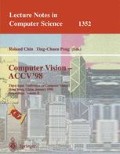Abstract
Shape-from-silhouettes, a simple approach to 3D shape understanding, can also be used for recovering posture and motion of human bodies. Silhouettes are easy to obtain from intensity images, do not require foreign objects attached to the subject, can directly provide a 3-D reconstruction of the body, or drive model-based motion capture. The purpose of this work is to demonstrate the effectiveness of this approach in a virtual environment, and to investigate number and position of stationary cameras suitable for precise reconstruction of the 3-D posture and motion of the human body.
Preview
Unable to display preview. Download preview PDF.
References
K. Rohr, “Toward model-based recognition of human movements in image sequences,” CVGIP: Image Understanding, vol. 59, no.1, pp.94–115, 1994
M. K. Leung and Y. H. Yang, “First sight: a human body outline labeling system,” IEEE Trans. on PAMI, vol. 17, no. 4, pp.359–377, 1995
D. Marr and H. K. Nashihara, “Representation and recognition of the spatial organization of threedimensional shapes,” Proc. R. Soc. London, vol.B 200, pp.269–294,1978
R. Mohan and R. Nevatia, “Using perceptual organization to extract 3D structures,” IEEE Trans. on PAMI, vol. 11, no. 11, pp.1121–1139, 1989
F. Solina and R. Bajcsy, “Recovery of parametric models from range images from range images: The case for superquadrics with global deformation,” IEEE Trans. PAMI, vol. 12, no. 2, pp. 131–147, 1990
I. Biederman, “Recognition-by-components: A theory of human image understanding,” Psychological Rev., vol.94, no. 2, pp.115–147, 1987
A. Pentland and B. Horowitz, “Recovery of nonrigid motion and structure,” IEEE Trans. on PAMI, vol. 13, no. 7, pp.730–742, 1991
A. Pentland and S. Sclaroff, “Closed-form solutions for physically based shape modeling and recognition,” IEEE Trans. on PAMI, vol. 13, no. 7, pp.715–729, 1991
R. Rashid, “Toward a system for the interpretation of moving light displays,” IEEE Trans. on PAMI, vol. 2, no. 6, pp.574–581, 1980
J. Webb and J. Aggarwal, “Structure from motion of rigid and jointed objects,” Artif. Intell. vol. 19, pp. 107–130, 1982
H. Lee and Z. Chen, “Determination of 3D human body posture from a single view,” Comput. Vision, Graphics and Image Processing, vol.30, pp. 148–168,1985
N. Ahuja and J. Veenstra, “Generating octrees from object silhouettes in orthographic views,” IEEE Trans. on PAMI, Vol. 11, pp.137–149, 1989
Noborio et al., “Construction of the octree approximating three-dimensional objects by using multiple views”, IEEE Trans. on PAMI, Vol.10, pp.769–782, 1988
M. Potemesil, “Generating octree models of 3D objects from their silhouettes in a sequence of images”, Comput.Vision Graphics Image Process., Vol.40, pp.1–29, 1987
C. H. Chian and J. K. Aggarwal, “Model reconstruction and shape recognition from occluding contours”, IEEE Trans.on PAMI, Vol.11, pp.372–389, 1989
W. N. Martin and J. K. Aggarwal, “Volumetric description of objects from multiple views”, IEEE Trans. on PAMI, Vol.5, pp.150–158, 1983
P. Srinivasan et al., “Computational geometric methods in volumetric intersection for 3D reconstruction”, Pattern Recognition, Vol.23, pp.843–857, 1990
A. Laurentini, “The visual hull concept for silhouette-based image understanding,” IEEE Trans. Patt. Anal. Machine Intell., vol. 16, no.2, pp. 150–162, 1994
A. Laurentini, “How far 3-D shapes can be understood from 2-D silhouettes,” IEEE Trans. Pattern Anal. Machine Intell., vol.17, no.2, pp.188–195, 1995
A. Laurentini, “How many 2d Silhouettes does it take to reconstruct a 3d object,” Computer Vision and Image Understanding, vol.67, no.1, July, pp.81–87, 1997
R. Y. Tsai, “A versatile camera calibration technique for high-accuracy 3D machine vision metrology using off-the-shelf TV cameras and lenses,” IEEE Journal of Robotics and Automation, Vol.RA-3, no.3, pp.323–344, 1987
S. Fantin, M. Dias, “3D Virtual Mannequin Database” ENEA, document E65334/ENEA/WP2-03.00, l/12/1994.
Author information
Authors and Affiliations
Editor information
Rights and permissions
Copyright information
© 1997 Springer-Verlag Berlin Heidelberg
About this paper
Cite this paper
Bottino, A., Laurentini, A., Zuccone, P. (1997). Toward non-intrusive motion capture. In: Chin, R., Pong, TC. (eds) Computer Vision — ACCV'98. ACCV 1998. Lecture Notes in Computer Science, vol 1352. Springer, Berlin, Heidelberg. https://doi.org/10.1007/3-540-63931-4_244
Download citation
DOI: https://doi.org/10.1007/3-540-63931-4_244
Published:
Publisher Name: Springer, Berlin, Heidelberg
Print ISBN: 978-3-540-63931-2
Online ISBN: 978-3-540-69670-4
eBook Packages: Springer Book Archive

